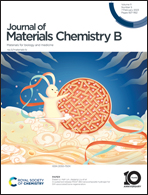Bilayer dressing based on aerogel/electrospun mats with self-catalytic hydrogen sulfide generation and enhanced antioxidant ability†
Abstract
Hydrogen sulfide (H2S) releasing wound dressings have attracted much attention for their ability to promote cell proliferation, stimulate angiogenesis, and resist inflammation. Mimicking the skin structure, a bilayer wound dressing based on aerogel/mats with H2S release capability was designed and fabricated. A bio-macromolecular H2S donor based on a keratin–TA conjugate (KTC) was first synthesized through a thiol–disulfide exchange reaction. As an inner layer, KTC was then loaded into a gelatin hydrogel with large pores to absorb the wound exudates and generate H2S self-catalytically. Subsequently, polyurethane was electrospun with glutathione (GSH) to be used as an outer layer with small pores, which provided mechanical support, supplied GSH, and prevented bacterial invasion. The bilayer dressing was capable of generating H2S self-catalytically, achieving a controlled and sustained release. The dressing could also promote cell proliferation and migration. In addition, the dress possessed enhanced antioxidant ability and reactive oxygen species (ROS) scavenging capability. The bilayer dressing on promoting wound healing was investigated in a full-thickness excisional cutaneous wound model in rats. The results demonstrated that it could reduce inflammation, promote vascularization, and facilitate hair follicle regeneration, thereby accelerating wound healing. Overall, the bilayer dressing has great potential applications in the field of the wound dressing.

- This article is part of the themed collection: 2023 Journal of Materials Chemistry B HOT Papers


 Please wait while we load your content...
Please wait while we load your content...